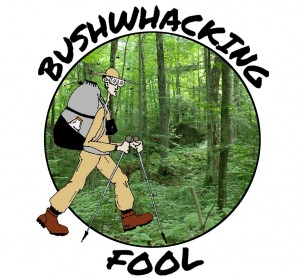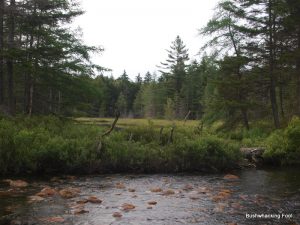
Elbow Pond
From the Red Horse Trail just north of Witchhopple Lake, my route takes me northeast back into the untrammeled forest of the southern Five Ponds Wilderness Area and toward Negro Lake. After the brief trail hiking earlier, it feels good to be bushwhacking again, especially when the forest is this easy going. The lack of ground cover and the relatively sparse mature trees allow for a good pace, not up to the trail hiking, but close.
Unfortunately, my haste remains a nearly futile attempt to leave the mosquito horde behind me. Just glancing over my shoulder to see the insect swarm taking shelter behind my head fills me with trepidation. It takes a Herculean effort to refrain from running in terror from being pursued by such a hungry mob. Pretending they are merely a bunch of headhunters provides little consolation.
My plan is to follow Witchhopple Lake’s northern inlet stream all the way to where it exits from the western end of Negro Lake. However, my initial destination is Elbow Pond, a J-shaped stretch of stream surrounded by open wetland. On the map, it appears more as a widening of the stream rather than a pond, but apparently the map makers do not agree. Its name is obviously derived from it being shaped somewhat like an arm, with the elbow being where the stream takes a sudden job as it flows southwest.
Section Stats:
Date: June 27, 2015
Length: 2.0 miles (3.6 total daily miles; 16.0 total trip miles)
Difficulty: Moderate
The forest remains a mixture of deciduous and coniferous trees right from the get-go, changing little as I bushwhack along the stream. Although the upper canopy is mixed, the understory is mostly witchhobble and ferns. A subtle herd path allows for making pretty good time, but I keep losing and regaining it on a regular basis, which causes a herky-jerky progress toward my destination.
After five minutes of bushwhacking, sunshine begins to break through the forest to the south, indicating an open wetland where the stream from Negro Lake enters Witchhopple Lake. Soon I find myself drawing close to the open wetland, where I find an opening that provides a nice view. A widening of the stream lies close to the edge of the forest, while off into the distance is an extensive grassy wetland. Even farther out, there is a glimpse of Witchhopple, giving me an idea of how fast I am leaving the attractive waterbody behind.
Although the understory remains sparse here, I decide to follow my northeastern bearing rather than capitulate to the temptation of following along the stream. As I continue on along a moderate slope, the open stream remains visible for a time to the south before gradually succumbing to the surrounding forest.
The understory remains fairly sparse, almost nonexistent in some places. This makes drawing a bearing exceedingly easy, allowing me to keep a rather fast pace and make up some of the time lost that I spent surveying new parts of the Red Horse Trail earlier this morning.
The sound of the stream gets louder after a while, signaling it is closer to me and perhaps shallower and rocky. Despite the noise, the stream remains invisible to me, as is has become completely absorbed within the forest now. The stream’s noise makes it much more difficult to resist the temptation of checking it out. Unfortunately, I can only resist it for so long before I capitulate and veer toward it for a look.
As I draw near, the stream appears much as I imagined it. It is wide, but relatively shallow, with a scattering of rocks protruding from its surface. It would be impossible to ford without getting wet, but it could be done without too much effort. The sound of the water cascading over the rocks is comforting, as is its shallower water level, especially given the wet summer this year. Hopefully, it and the surrounding area streams stay that way after the next few days’ rain.
Returning to my northeast bearing, the stream and I gradually part company again. I head upslope somewhat and then remain along the slope as I continue to draw closer to Elbow Pond. The forest remains a mixture of hardwoods and conifers down near the stream, while hardwoods increasingly dominate farther upslope to the north.
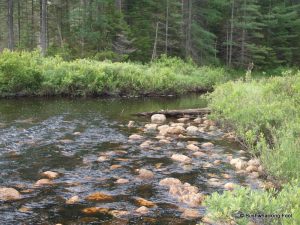
Stream near Elbow Pond
Conifers start dominating the upper canopy down slope after some distance, signally to me that Elbow Pond is most likely drawing nearer. As increasing amounts of light penetrate through the forest in the direction of the stream, I veer off in that direction, heading downslope, eager to see if I can get a good view of the so-called pond.
When reaching the edge of a grassy cleaning, I am reluctant to venture out too far, as it appears quite wet. The location provides nothing but a sliver of open water, entirely of a swiftly flowing stream, but a slight peninsula a little further northeast suggests a much better view. So, it is back into the forest with me for a while, before making a second attempt to see this pond from the peninsula.
After heading into the forest for a short distance, I make another attempt to get at least a glimpse of Elbow Pond. The peninsula contains denser conifers than previously encountered, but not even close to being the worst I have ever ventured into. In fact, it remains fairly easy going, but unfortunately, I fail to find an opening that provides a much better view.
After a brief water break, I throw my pack on my back and continue on. With a forecast of rain this afternoon, I abandon any further attempt to get a better look at Elbow Pond and instead turn northeast once again, this time toward Long Island Pond.
This new pond is not much different than Elbow, appearing on the map as more of a widening of the stream, rather than a full-blown pond. It apparently gets its name from a small dot of an island that appears at the junction of two streams, the outlet of Negro Lake and a stream that originates off a ridge to the east.
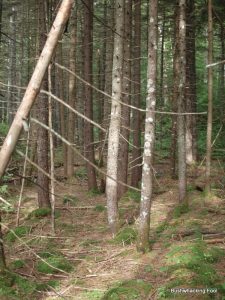
Forest near Elbow Pond
The terrain remains level as I move away from the vicinity of Elbow Pond. The forest is mostly mixed, with hardwoods dominating more to the northwest, while softwoods take the southeast, in the direction of the stream. Since the forest near the stream may be thick and coniferous, I attempt to maintain this sweet spot where I might see the stream occasionally (or at least the increase in sun penetration through the canopy), but avoid the poking and prodding of sharp branches that are characteristic of coniferous forests.
Unfortunately, the forest fails to cooperate and becomes increasingly more coniferous. The terrain gradually becomes more rolling too, so I veer north up onto a shallow ridge where I hopefully will avoid much of the floodplain conifers to the southeast. The ridge is significantly more hardwood, so I am content to stay on it as long as it continues in the northeastern direction.
The ridge allows for me to remain along to the hardwood/softwood forest edge, avoiding a lot of obstacles and making good time. However, the stream stays out of sight to the southeast, though the light breaking through the forest canopy suggests where it may be located.
After crossing a small stream, which appears likely to be seasonal but surging now due to the ample recent rainfall, the forest becomes almost entirely hardwood along the ridge, at least in the upper canopy. Soon, I notice a small conifer with an injury on its trunk at about eye level. When I draw closer, the injury appears man-made, as though it might have once been a slash to mark an unofficial trail. No other markers seem are within eyesight though, and my haste to avoid the approaching rain prevents me from taking much time to search for any.
While bushwhacking at a pretty swift pace, a small insect, probably a mosquito, uses poor judgement and flies too close to my mouth just as I am inhaling, sucking the thing down my throat. The damn thing gets caught down there, but not before my taste buds have a shot at it, the combination causing me to gag vigorously. Why do these things need to taste so badly? Perhaps covering them in dark chocolate would improve their taste.
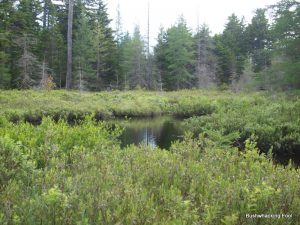
Elbow Pond
Having a horde of chocolate-covered flies flying around my head would not be such a bad thing, especially as it would allow me to carry a lot less snacks.
After over twenty minutes of bushwhacking since leaving Elbow Pond, the understory starts to fill in, becoming increasingly thicker, though mostly below the knee. Although it is thicker along the ridge, it appears much worse to the southeast toward the stream’s location. Looks like I made a wise decision to stay away from the stream and remain in the forest instead.
I remind myself not to get too cocky, as the forest gods have a way of punishing a poor bushwhacker when they do so.
Sunlight appears increasingly intense coming from the southeast, suggesting Lost Island Pond is most likely approaching. From the map, the so-called pond appears to have a grassy wetland boundary, much like Elbow Pond did before it. This likely means any kind of up-close view will turn out to be impossible, or at the very least, uninteresting.
My route takes me along a southeastern facing slope now, adding more credence to the theory that the pond is out of sight and off to the southeast. Gaps in the forest canopy suggest a grassy wetland, which suggests that I may pass the pond without even knowing it.
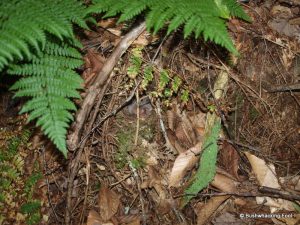
Bird nest
Another small stream appears across my path; although it appears more permanent than the previous one, it is easy enough to cross. Soon after the stream crossing is a more difficult obstacle, a jumble of downed logs, branches and rocks. Instead of taking the safe route and detour around, I carefully navigate through the mess, carefully placing my feet with every step.
Suddenly, a bird sounds the alarm, vigorously chirping as I pick my way across the mess. A pair of black-and-white warblers lurks about looking suspicious, but it is unclear whether they are the ones vocalizing a fuss or not. Just looking around, I spot a nest on the ground under a wood fern, complete with several chicks. It is impossible to discern their number, as they lie in a tangle, most likely hiding from yours truly.
After taking a few photographs of the nest, I move on and continue to the northeast for a while to put some distance between me and the poor parents. When I arrive at a flat area, I decide it is time for a break and an assessment of where I currently am, as well as a drink and a snack. Natures call is the priority though, which I decide should definitely not be video recorded.
When I start bushwhacking again, I continue through a mostly hardwood forest, with a scattering of small boulders showing through the surrounding leaf litter. The terrain remains level, but soon I find myself along the side of a low ridge, just like before. In a short distance, I cross another small meandering stream, looking more like another seasonal one rather than anything permanent. After the stream crossing the surrounding area becomes more open, with a swampy forest appearing a short distance to the southeast.
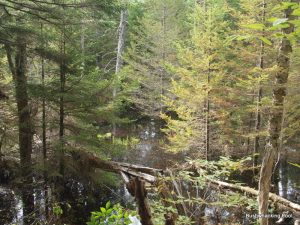
Flooded area near Lost Island Pond
Veering south in an attempt to see Lost Island Pond, I arrive at the shore of a newly flooded forest. Apparently, busy beavers are putting all the prodigious amounts of recent precipitation to use by damming up this area for their own purposes. Many live trees remain standing within the water, some coniferous, others broadleaf, with all containing most of their foliage. Beaver-gnawed sapling stumps are common along the shoreline, as the water has encroached within the forest.
Continuing on, I return to the northeast bearing and start climbing to higher ground minutes after leaving the newly flooded area. Evidence of beavers (i.e. chewed down small hardwood trees) are frequent as I pull away, showing that the large rodents are venturing farther away from open water to find food materials.
As the flooded area is left further away, and the uninterrupted forest reclaims my surrounding, it appears I am leaving Lost Island Pond behind without ever really getting a good view of the open water or that infamous island.
I guess it will remain lost for a little while longer now.
Affiliate Disclaimer: Some links and advertisements on this blog post and elsewhere on the Bushwhacking Fool may send you to a retailer’s website. If you chose to purchase any product on that site, this author may receive a small commission at no extra cost to you. These commissions provide compensation for the author’s time and effort necessary to provide the content at the Bushwhacking Fool. If you enjoy the content on the Bushwhacking Fool, please show your appreciation by purchasing products through links and advertisements on this site.
